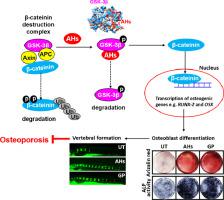Phytomedicine ( IF 6.7 ) Pub Date : 2021-08-17 , DOI: 10.1016/j.phymed.2021.153721 Wisurumuni Arachchilage Hasitha Maduranga Karunarathne 1 , Ilandarage Menu Neelaka Molagoda 2 , Kyoung Tae Lee 3 , Yung Hyun Choi 4 , Cheng-Yun Jin 5 , Gi-Young Kim 2

|
Background
The bark and petal of Hibiscus syriacus L. (Malvaceae) have been used to relieve pain in traditional Korean medicine. Recently, we identified anthocyanin-enriched polyphenols from the petal of H. syriacus L. (AHs) and determined its anti-melanogenic, anti-inflammatory, and anti-oxidative properties. Nevertheless, the osteogenic potential of AHs remains unknown.
Purpose
This study was aimed to investigating the effect of AHs on osteoblast differentiation and osteogenesis in osteoblastic cell lines and zebrafish larvae. Furthermore, we investigated whether AHs ameliorates prednisolone (PDS)-induced osteoporosis.
Study design and methods
Cell viability was assessed by cellular morphology, MTT assay, and flow cytometry analysis, and osteoblast differentiation was measured alizarin red staining, alkaline phosphatase (ALP) activity, and osteoblast-specific marker expression. Osteogenic and anti-osteoporotic effects of AHs were determined in zebrafish larvae.
Results
AHs enhanced calcification and ALP activity concomitant with the increased expression of osterix (OSX), runt-related transcription factor 2 (RUNX2), and ALP in MC3T3-E1 preosteoblast and MG-63 osteosarcoma cells. Additionally, AHs accelerated vertebral formation and mineralization in zebrafish larvae, concurrent with the increased expression of OSX, RUNX2a, and ALP. Furthermore, PDS-induced loss of osteogenic activity and vertebral formation were restored by treatment with AHs, accompanied by a significant recovery of calcification, ALP activity, and osteogenic marker expression. Molecular docking studies showed that 16 components in AHs fit to glucagon synthase kinase-3β (GSK-3β); particularly, isovitexin-4′-O-glucoside most strongly binds to the peptide backbone of GSK-3β at GLY47(O), GLY47(N), and ASN361(O), with a binding score of -7.3. Subsequently, AHs phosphorylated GSK-3β at SER9 (an inactive form) and released β-catenin into the nucleus. Pretreatment with FH535, a Wnt/β-catenin inhibitor, significantly inhibited AH-induced vertebral formation in zebrafish larvae.
Conclusion
AHs stimulate osteogenic activities through the inhibition of GSK-3β and subsequent activation of β-catenin, leading to anti-osteoporosis effects.
中文翻译:

来自 Hibiscus syriacus L.(锦葵科)的富含花青素的多酚通过抑制 GSK-3β 并随后激活 β-catenin 发挥抗骨质疏松作用
背景
Hibiscus syriacus L.(锦葵科)的树皮和花瓣在韩国传统医学中已被用于缓解疼痛。最近,我们从H. syriacus L. (AHs)的花瓣中鉴定了富含花青素的多酚,并确定了其抗黑色素生成、抗炎和抗氧化的特性。然而,AHs的成骨潜力仍然未知。
目的
本研究旨在研究 AHs 对成骨细胞系和斑马鱼幼虫成骨细胞分化和成骨的影响。此外,我们研究了 AHs 是否可以改善泼尼松龙 (PDS) 诱导的骨质疏松症。
研究设计和方法
通过细胞形态学、MTT 测定和流式细胞术分析评估细胞活力,并通过茜素红染色、碱性磷酸酶 (ALP) 活性和成骨细胞特异性标志物表达测量成骨细胞分化。在斑马鱼幼虫中测定了 AHs 的成骨和抗骨质疏松作用。
结果
AHs 增强钙化和 ALP 活性,伴随着 MC3T3-E1 前成骨细胞和 MG-63 骨肉瘤细胞中 osterix (OSX)、矮小相关转录因子 2 (RUNX2) 和 ALP 的表达增加。此外,AHs 加速了斑马鱼幼虫的脊椎形成和矿化,同时增加了OSX、RUNX2a和ALP 的表达。此外,PDS 诱导的成骨活性丧失和椎体形成通过 AHs 治疗得以恢复,伴随着钙化、ALP 活性和成骨标志物表达的显着恢复。分子对接研究表明,AHs 中有 16 种成分与胰高血糖素合酶激酶-3β(GSK-3β)相匹配;特别是,isovitexin-4'- O-glucoside 在 GLY47(O)、GLY47(N) 和 ASN361(O) 处与 GSK-3β 的肽骨架结合最强,结合评分为 -7.3。随后,AHs 在 SER9(一种非活性形式)处磷酸化 GSK-3β,并将 β-连环蛋白释放到细胞核中。用 Wnt/β-catenin 抑制剂 FH535 预处理可显着抑制 AH 诱导的斑马鱼幼虫椎体形成。
结论
AHs 通过抑制 GSK-3β 和随后激活 β-catenin 来刺激成骨活性,从而产生抗骨质疏松症的作用。











































 京公网安备 11010802027423号
京公网安备 11010802027423号